subcutaneous
Situated or applied under the skin
subcutaneous
Situated or applied under the skin
plasma
Plasma is a yellowish liquid component of blood that holds the blood cells of whole blood in suspension. It is the liquid part of the blood that carries cells and proteins throughout the body.
insulin
A hormone produced in the pancreas which regulates the amount of sugar in the blood. The lack of insulin causes a form of diabetes.
COMSOL
A simulation software to create accurate models
in vivo
In a living organism
perforation
A hole made by puncturing or piercing
GI fluid
Fluid that aids digestion
sucrose
A common sugar
isomalt
A sugar substitute
micro–computed tomography (micro-CT)
3D imaging technique using x-rays to see the inside of an object by viewing it slice by slice
Histology
The study of the microscopic structures of tissues
autonomously
Acting independently; the ability to act without instruction
permeation
becoming widely spread
parenteral
Occuring or administered elsewhere in the body other than the mouth
gastrointestinal (GI) tract
The GI tract is a series of hollow organs that form a long tube from the mouth to the anus. The organs within the tract include the mouth, esophagus, stomach, small intestine, large intestine, and anus.
Biomacromolecules
Biomacromolecules are the building blocks of life. The different macromolecules are: Proteins, Lipids, Carbohydrates, and Nucleic Acids. Each of these macromolecules are responsible for different biological functions within the body and the cells
luminescence
This is the emission of light from an object that is not a result of heat, but a form of cold-body radiation.
bioluminescence
This is the production and emission of light by a living organism.
Cross-contamination
the process by which bacteria or other microorganisms are unintentionally transferred from one substance or object to another, with harmful effect.
Use display as a general term for any visual output device, including the built-in display on a computing device and an external monitor or projector.
Definición de inflamación
Definición etimológica
Introgressive hybridization
Movement of genes from one species into the gene pool of another species by the repeated crossing of a hybrid with one of its parents.
missense mutation
Where a single nucleotide base is changed, which results in a different amino acid.
Body copy, body text, or sometimes just plain body or text refers to themain block of text that you read, as opposed to headlines, subheads, titles,etc. Body text is usually set between 9- and 12-point type with 20 percentadded space between the lines.
body copy, body text
mantle
A part of Earth’s interior that lies between the dense, extremely hot core and the thin outer layer, known as the crust. It is made up of a thick, rocky shell that constitutes 84% of Earth’s volume. In geologic time, it behaves as a viscous fluid.
continental plume–related basalts
Both ocean island basalts and continental plume-related basalts come from deep within the mantle. OIBs intruded into oceanic (basaltic) crust, whereas continental plumes intrude into continental crust (for example, Deccan traps in India).
coesite
This is a high-pressure and high-temperature polymorph (version) of quartz.
anterior
This is an anatomical term which refers to the front of the body, or near the head.
In the case of planaria, it refers to the head.
posterior
This is anatomical term which refers to the back of the body, or near the hind end of the body.
In the case of planaria, it refers to the the hind end.
“Janus heads”
Janus was a Roman god and doorkeeper to the heavens. Relevant here, Janus was usually depicted with two heads, one facing the past and the other towards the future.
protrusions
Here, protrusions refer to bulges of cells.
periphery
Refers to the outer edge.
signaling pathways
A series of linked chemical pathways in which one chemical in the series activates another chemical in the pathway, which ultimately leads to a specific cell function.
β-catenin antagonist adenomatous polyposis coli
Adenomatous polyposis coli, or APC, is gene that plays many roles, including acting as a tumor suppressor. APC has also been found to play a role in cell division and directing cells where to go once division takes place. In order to do its job, APC directs β-catenin in the Wnt signaling pathway.
Read more in the Journal of Cell Science. The PDF is also available in the "Related content" tab.
RNA interference (RNAi)
A mechanism used by both plant and animal cells to silence a gene using a double-stranded DNA molecule. DNA is converted into the smaller RNAi molecules used to turn genes off. Scientists are now able to use this natural process to turn off genes they are studying so they can learn more about their function.
Schmidtea mediterranea
This is an image depicting this common planarian.

secondary challenge
A second exposure to the same threat. The immune system is, under certain conditions, able to remember threats it has encountered before and react to them more quickly and effectively upon each subsequent exposure.
T cells
White blood cells central to adaptive immunity. T cells are able to recognize when cells are diseased and can kill them so they don't spread throughout the body.
channelrhodopsins
This family of proteins is employed to activate neurons by driving cations (including sodium, calcium, hydrogen, and potassium) into the cell and causing the membrane potential to become more positive, leading to depolarization.
halorhodopsins
Halorhodopsins and bacteriorhodopsins typically inactivate neurons by driving chloride ions into the cell or hydrogen ions out of the cell and causing the membrane potential to become more negative, leading to hyperpolarization.
cation
A positive ion like hydrogen (H+), sodium (Na+), or potassium (K+).
Cannula
A tube inserted into the body to facilitate the delivery of fluids or materials to a specific region.
basal ganglia (BG)
A group of nuclei located at the base of the forebrain that is responsible for motor control and cognition.
globus pallidus pars interna (GPi)
Major component of the basal ganglia that targets the substantia nigra.
contralateral
Opposite the lesion.
substantia nigra pars compacta (SNc)
A subregion of the midbrain responsible for motor control.
neurodegenerative
Progressive loss of function of neurons, usually a result of neuron death.
Error bars
A graphical representation (usually lines through a point on the graph that run parallel to one of the axes) showing the amount of uncertainty there is in the location of that point. All scientific data collection includes uncertainty; error bars allow researchers to show how confident they are in their results. Large error bars mean there is a lot of uncertainty (lower confidence), whereas smaller error bars mean there is less uncertainty.
β
A statistical term, the Greek letter beta, refers to the probability that you can accept the null hypothesis (which states that values affirmation has no effect) when in fact the null hypothesis is wrong.
racial achievement gap
The difference in performance (for example, on standardized tests) between minority students and white students.
standardized test
Any form of an exam that requires all people taking the test to answer the same questions and is scored the same way in all cases, so that comparisons can be made between all people who take the test. These are typically multiple choice tests taken by large populations of students (for example: all 8th grade students in the United States).
psychological threat
Any outside force (real or perceived) that challenges a person's values, beliefs, or sense of self.
Stereotype (or identity) threat is a subset of psychological threat in which a person feels they will be judged according to common prejudices about some aspect of their identity (for example: race, ethnicity, or gender).
double-blind study
An experiment in which neither the participants nor the experimenters know which group each participant is assigned to until after the data are analyzed.
values affirmation
An intervention in which people reflect on and write about the beliefs and values (e.g., family, integrity) that are important in their lives.
silencing
Turning a gene off so that it does not go through transcription and translation (gene expression) which prevents the production of its protein product (β-catenin) being made by the cell.
constitutive degradation
The regulated breakdown of a cell or cellular product, which is used to control gene expression and ultimately cellular function. In this case, the breakdown of APC leads to an increase in β-catenin.
transcriptional output
The copying of DNA into mRNA, which is the first step in the process known as gene expression.
Watch this video to learn more about the role of transcription and transcription factors: https://www.hhmi.org/biointeractive/signal-molecules-trigger-transcription-factors
regenerate
Regeneration in this case, refers to the replacement of lost or damaged tissue.
This video will help you understand the process of tissue regeneration: https://www.hhmi.org/biointeractive/tissue-regeneration-animals
A/P misspecification
The cells that were supposed to be in the posterior end migrated to the anterior end of the animal, or vice versa.
upstream components
The chemicals at the beginning of the signaling pathway.
protein perdurance
How long the protein lasts as part of the signaling pathway.
penetrance
The percentage or proportion of individuals with the genotype that present the phenotype. In other words, organisms may have the genes by may not show the trait. You can find more information about these terms in this article: https://www.ncbi.nlm.nih.gov/books/NBK22090/
homeostasis
The ability or tendency of an organism to maintain internal stability. This includes maintaining certain ranges of physiological processes such as temperature, pH, or ions such as calcium.
anteroposterior
Genes are used to create both a front and a back for an organism during early embryonic development.
molecular switch
A molecule, such as a protein, than controls gene expression by either turning it on or off.
cell adhesion
Specialized protein complexes that allow cells to stick to each other.
freshwater planarians
Freely swimming flatworms from the taxonomic class Turbellaria that inhabit freshwater.
amputation
For most organisms it involves removal of a limb. Planaria do not have limbs, so in this case refers to removing either the front or hind end of the body.
concomitant
Refers to events that occurred at the same time and are associated with each other.
placental mammals
Members of this group of mammals (which includes humans) carry the developing fetus in the uterus, where the placenta facilitates the exchange of nutrients and wastes between the mother and the fetus.
chelydroid turtles
These turtles are related to modern snapping turtles and have a similar morphology. They had large heads and long tails.
crevasse splay
These are floodplain deposits made when the river broke through its natural flood banks. Heavier sediments are deposited closer to the river channel, while lighter sediments, such as sand and silt, are deposited farther away from the channel.
benthic foraminifera
These are single-celled, bottom-dwelling organisms that live on or within the carbonate-rich sediment surface. https://www.biointeractive.org/classroom-resources/foraminiferaearths-microscopic-recordkeepers
dicotyledonous (dicot)
This is one of the two groups angiosperms are traditionally divided into. A number of traits distinguish dicots from the other group, the monocotyledons (monocots). The seeds of dicots contain two embryonic seed leaves; monocot seeds contain one.
Deccan Traps
This is one of the largest volcanic areas on Earth. Its lava flows cover an area of about 500,000 square kilometers.
Puercan (Pu3) index
This stage of the geologic timescale refers to the North American faunal stage, spanning from 66,000,000 to 63,300,000 years BP (Before Present).
Cretaceous–Paleogene mass extinction (KPgE)
The extinction event that wiped out nearly three-quarters of all plant and animal species on Earth 66 million years ago.
ka
The abbreviation for "kilo annum." It signifies time in thousands of years.
stratigraphic
Refers to the study of rock layers that can be understood over a large area.
Learn more about stratigraphic principles with HHMI BioInteractive: https://www.biointeractive.org/classroom-resources/stratigraphic-principles
reproductive isolation
Means that the species cannot breed to produce fertile offspring because of some barrier. That barrier could be geographic, behavioral, or some other type. A well-known animal that is reproductively isolated is the mule.
allelic series
The alleles for a certain locus listed according to their dominance, that is, their effect on the phenotype they affect.
linkage disequilibrium
This term means that the association of certain alleles at different loci is not random. Essentially, certain alleles of certain genes are often linked together and found in these combinations in the Big Birds.
genetic drift
Occurs when the frequency of alleles in an organism changes due to chance. Genetic drift (sometimes referred to as drift) is strongest in small populations such as the one studied here, because chance (random sampling) strongly affects the alleles present in the population.
bill
As in a bird's beak.
transgressive segregation
When hybrid offspring show traits that are more extreme than those of the parents. For example, when a hybrid plant offspring is much taller than, or much shorter than, either of the parent plants.
lineage
Here, a genetic group of individuals that are all descended from one initial ancestor.
hybrid speciation
Referring to the formation of a new species when two different species mate to produce a new species.
dextran perfusion
Definition: A polysaccharide glucan that is medically used to reduce blood viscosity.
For the paper: Dextran perfusion is based on flowing a dextran solution through the tube/pipe to determine whether it is hollow (allows fluid flow), and transports fluids as expected.
pulsatile perfusion
A specific type of perfusion (previously defined) that moves through channels based on motion similar to that of heart pumping blood to the body.
porcine
Lab testing relating to pigs
CD31-positive
A protein that is involved in angiogenesis activation.
cell-laden hydrogels
Hydrogels loaded with live cells.
For the paper, this is an appealing option that helps engineering potential tissue constructs with biomimetic structure and function. Cell-laden hydrogel is a promising scaffolding system for engineering artificial bone, cartilage, cardiac and neural tissues.
LIVE/DEAD staining confirmed high viability
Staining that is a fluorescence assay (as shown in image on Panel E) which shows cell viability, that is whether the cells are dead or live. The live cells emit green light where the dead cells emit red light.
thermoreversible
Whose properties can be changed back and forth by increasing or decreasing temperature.
For the article, specific thermoreversible hydrogels form a gel when cooled and return to a viscous fluid state when exposed to heat.
perfusion
The passage of blood or fluids through blood vessels or other channels in an organ or tissue.
In this paper, perfusion is needed to sustain healthy tissues and organs.
micro–computed tomography (μCT)
Micro-computed tomography (Micro-CT) is a 3D imaging technique utilizing X-rays to see inside an object, slice by slice. It is similar to a CT scan, but on a micro-scale. Micro-CT provides high resolution 3D imaging of the interior structure of materials and biological samples without having to cut the samples.
endothelial
cells that are on the inner surface of blood vessels
regurgitation
Leaky heart valves. A condition in which the heart valve doesn't close tightly, which allows blood to flow backward in the heart.
perfusable vascular-like networks
Artificial blood vessel structures through which one can flow fluids which nurture cell growth.
patent and manifold
Unobstructed (open inside allowing for fluid flow) and has several outlets to be connected to other tubes/pipes, similar to the arteries and veins in our body.
G-code
G-code is a language that humans use to tell a machine how to do something. With 3D printing, g-code contains commands to move parts within the printer.
micro–computed tomography
Micro-computed tomography (Micro-CT) is a 3D imaging technique utilizing X-rays to see inside an object, slice by slice. It is similar to a CT scan, but on a micro-scale. Micro-CT provides high resolution 3D imaging of the interior structure of materials and biological samples without having to cut the samples.
tri-leaflet valves
The aortic valve of the human heart typically contains three leaflets or cusps, hence called the tri-leaflet valve. When the valve opens it allows blood to exit the left ventricle into the aorta. Once closed, blood movement stops. In the case of a dysfunction, the tri-leaflet valve is repaired or replaced by a surgery. The technology described in this article provides a promising approach to create artificial implants for these surgeries.
pH-driven gelation
Hydrogels are 3D networks of hydrophilic polymers that can hold a lot of water while still maintaining structure. They resemble tissue structure when scaffolded and can nurture cell growth and vessel formation. Hydrogels can be assembled by chemical processes. In this study, authors used pH-driven assembly (gelation).
micro–computed tomography (μCT)
Micro-computed tomography (Micro-CT) is a 3D imaging technique utilizing X-rays to see inside an object, slice by slice. It is similar to a CT scan, but on a micro-scale. Micro-CT provides high resolution 3D imaging of the interior structure of materials and biological samples without having to cut the samples.
A negative Nb anomaly characterizing the involvement of subducted material is present in all the trace-element patterns of our studied samples. This anomaly implies that a recycled crustal component, and not the ambient mantle, dominates the trace-element budget in the fluid inclusions.
Negative Nb anomalies are characteristic of subducted material. Subducted material includes continental-sources sediments from the ocean floor that gets subducted into the mantle. The trace element patterns look more like the crust than the mantle, which means that the fluid inclusions' trace element record is not recording any mantle processes.
kimberlite
A kind of intrusive, igneous rock that is formed deep inside the Earth’s interior. Kimberlite tends to move upwards via the upper mantle and lower and upper crusts, ultimately reaching the surface of the Earth. When the rocks move up, they carry diamonds inside them, thereby becoming an important source of diamonds.
slab subduction
A slab is a part of the tectonic plate which undergoes subduction. Subduction is a geological phenomenon occurring at the junction between two tectonic plates. This involves pushing one plate below the other, so much so that the sinking plate (usually the denser one) protrudes into the Earth’s mantle.
mid–ocean ridge basalts
The mid-ocean ridge is one of the largest chain of volcanic mountains on Earth, with 90% of the mountains submerged underneath the ocean. A type of basaltic rock originating from volcanic eruptions in this region is known as mid-ocean ridge basalt.
Mid-ocean ridges occur where two tectonic plates pull apart and the mantle below wells up and then rapidly cools due to the interaction with the ocean's cold water. This is what makes up oceanic crust.
shallow crustal contamination
This occurs when magma inside the Earth's mantle gets polluted by small amounts of crustal rocks—that is, rocks from Earth's crust. Shallower crustal rocks are more felsic, which means they contain more feldspar and quartz.
gastric resident dosage form
A pill that stays in the stomach during drug release.
ANOVA
Analysis of Variance - statistical test used to determine whether there are any statistically significant differences between the means of three or more independent observables.
extracellular fluid
Any body fluid outside of the cells in any multicellular organism. This includes interstitial fluid and plasma.
levonorgestrel-releasing gastric resident dosage form
A smart pill that stays in the stomach during release of a drug (levonorgestrel) which prevents pregnancy.
electrostatic
an electric field/charge that is stationary
capacitor
a device that stores electrical energy between two conducting electrodes separated by a dielectric (nonconducting) material
Maxwell pressure
when a voltage is applied between electrodes pressure arises, the elastomer contracts in thickness and expands in area.
dielectric breakdown
occurs when current flows through a material whose electric charges do not flow freely
hydraulically amplified self-healing electrostatic (HASEL) actuators
A device which generates movement from electrical energy. The device consists of liquid segments which helps amplifying force generation and heals itself in case of an electrical breakdown.
Peak specific power
The peak specific power is the maximum power that the power supply can sustain for a short time.
endoscopic overtube
An endoscopic overtube is a sleeve-like device designed for both upper and lower endoscopic procedures. During upper endoscopy it is designed to protect the hypopharynx from the trauma of repeated intubations, the airway from aspiration, and the esophagus during extraction of sharp foreign bodies.
pharmacokinetics
A branch of pharmacology which studies how drugs are taken up, distributed, metabolized, and cleared from the body.
Poly(sebacic anhydride)
A biodegradable polymer substance used in drug delivery applications
patient adherence.
A patients commitment (how well a patient follows prescribed directions) to taking said medication at the correct time each day.
poly(dimethylsiloxane)
A silicon based elastomeric polymer used in biomedical applications.
hormonal contraception
methods of birth control which impacts hormones related to pregnancy
in vivo
in live being
oral contraceptives
A drug or device used to prevent pregnancy taken as a pill by mouth.
actuation
the action of causing a machine to operate
hydraulic
denoting, relating to, or operated by a liquid moving in a confined space under pressure.
soft robotics
a subcategory of robotics that deals with the construction of flexible robots to mimic living organisms
soft actuators
a lightweight, affordable, and easily customizable device component consisting of flexible material that converts energy into mechanical movement in order to move/control a part of the device
actuation strain
deformation produced by a non-mechanical stimulus
elastomer
a material that produces a large deformation when a voltage is applied
polymer fibers
man-made fibers consisting of synthetic chemicals
transducers
a device that converts an energy signal in to another form of energy signal
an example of this is mechanical energy being converted to electrical energy
ionically conductive polyacrylamide (PAM) hydrogels
a gel which contains significant amount of water and can conduct electricity
electrodes
an electrical conductor that makes contact with nonmetallic parts of a circuit
polydimethylsiloxane
the most widely used silicone based organic polymer
resonant frequency
Simply put, resonant frequency is the natural frequency at which it is easiest to get an object to vibrate. Most objects have several resonance frequencies, such as stringed musical instruments that vibrate at their resonance frequencies when plucked or struck, and their vibrations against the surrounding air produce sound. This type of resonance is found when an object is in equilibrium with acting forces and could keep vibrating for a long time under perfect conditions.
linear actuation
An actuator creating movement in a straight line, rather than a circular motion.<br> In this study, a fixed pre-stretch is applied in one direction (downward pull).
strain
the ratio of total deformation to the initial dimension of the material body upon application of external forces.
dielectric permittivity
this ability of a material to hold an electrical charge
fluidic actuators
a device component which uses hydraulic fluid pressure to convert energy into mechanical movement in order to move/control a part of the device.
neonatal
Newborn child
cell infiltration
Migration of cells into microporous structures.
slurry
A semiliquid mixture, typically of fine particles of manure, cement, or coal suspended in water. E,g, cake batter
cardiomyocytes
Heart muscle cells responsible for contracting of the heart.
collagen scaffolds
Scaffolds provide support for tissues and organs in the human body. In this article, the scaffolds are made from collagen, a structural protein used in connective tissues
extracellular matrix
A network of biological materials surrounding cells throughout the body for protection and support.
cellular infiltration
The ability of cells to occupy the porous structure in the hydrogel to create a tissue-like structure
yield stress
Highest amount of force an object can take before deforming.
pH
A scale from 1 to 14 determining how acidic or basic a solution is. 1 is most acidic, 14 is most basic, and 7 is neutral.
fidelity
Reproducibility of features (size and shape) with 3-D printing
decellularized
cells removed
fidelity
Reproducibility of features (size and shape) with 3-D printing
resolution
Smallest feature that can be written by 3-D printers.
graminoid
Grasslike plants.
physicochemical
Interactions of physics and chemistry.
hysteresis
When the direction of an ecosystem change cannot be reversed, i.e., an ecosystem cannot be returned to its previous state once it has gone through a phase shift.
predation
Killing other organisms for food.
interdisciplinary
Research involving more than one field of science, e.g., biology and chemistry.
biogeochemical cycles
Complex cycles of nitrogen, sulfur, phosphorus, carbon, and water involving the atmosphere, land, water, and organisms.
ecosystems
The interactions between organisms and the nonliving environment (i.e., rocks, water) within an area.
top-down forcing
The impacts that top-level predators have on the food web levels below them.
carbon sequestration
The storage of carbon atoms in organisms, soil, and water from the atmosphere
continental plume–related basalts
When large stretches of land are covered by lava generated from a massive volcanic eruption, a type of basaltic lava is created. Sometimes, these eruptions are also caused by movement of tectonic plates in the lithosphere. Such events when combined with abnormally hot rock in the Earth's mantle (mantle plume), give rise to continental plume-related basalts.
degassing
It is the process of removal of dissolved gases from liquids, especially aqueous solutions.
ACTIVITY 3: SYNCRHONOUS COMMUNICATION TOOLS
syn·chro·nous /ˈsiNGkrənəs/ Learn to pronounce adjective 1.existing or occurring at the same time.
ACTIVITY 2: ASYNCHRONOUS COMMUNICATION TOOLS
a·syn·chro·nous /āˈsiNGkrənəs/ Learn to pronounce adjective 1.(of two or more objects or events) not existing or happening at the same time. 2.COMPUTING•TELECOMMUNICATIONS of or requiring a form of computer control timing protocol in which a specific operation begins upon receipt of an indication (signal) that the preceding operation has been completed.
In telecommunications, asynchronous communication is transmission of data, generally without the use of an external clock signal, where data can be transmitted intermittently rather than in a steady stream. Any timing required to recover data from the communication symbols is encoded within the symbols.
blastemal cells
A mass of undifferentiated cells that has the ability to develop into an organ or body part, such as limbs.
thermal regimes
A pattern of temperatures
diel cycle
A 24-hour cycle, more commonly referred to as a "day".
ectothermic
Commonly called "cold-blooded", this term describes an animal that regulates its body temperature using external energy sources. For example, this is the reason why many reptiles sunbathe.
foraging
The search for food in the environment.
gestation time
The period of time that viviparous animals (those that give live birth and do not lay eggs) will carry a developing embryo. The length of this period will vary depending on species; for example humans have a gestation period of 40 weeks, whereas rabbits only take about a month.
scaling coefficient
Ecologists often use equations to try to describe animal behavior. A "scaling coefficient" is a number by which a variable is multiplied, which is used here to say that temperature (the variable in this case) will cause a larger change in the behavior of prey (large scaling coefficient) than predators (small scaling coefficient).
trevally
Caranx ignobilis, the "Giant trevally" is called out as an animal that has some key similarities and differences in behavior from the blacktip reef sharks at the center of this study.
While both are apex predators from the Phylum Chordata, the trevally is a bony fish (Class Actinopterygii) while the shark is a cartilaginous fish (Class Chondrichthyes)

sit and wait predators
Ambush predators which hunt using stealth or strategy (ex: house cat) rather than speed or strength (ex: cheetah).
covariate
Another term for a "variable" that was considered as part of the study as a factor that could potentially explain the behavior in question.
serial correlation
Also known as autocorrelation, this is a phenomenon that occurs within datasets such as a time series in which the data points are not independent of each other. For example, the temperature recorded one minute is very likely to be similar to the temperature that was recorded for the previous time point because these time points have a relationship to each other, as the temperature will only change as quickly between them as the underlying physics allow. This phenomenon has consequences for some statistical analyses that researchers must correct for to avoid generating spurious results.
Acanthurus lineatus
Striped surgeonfish 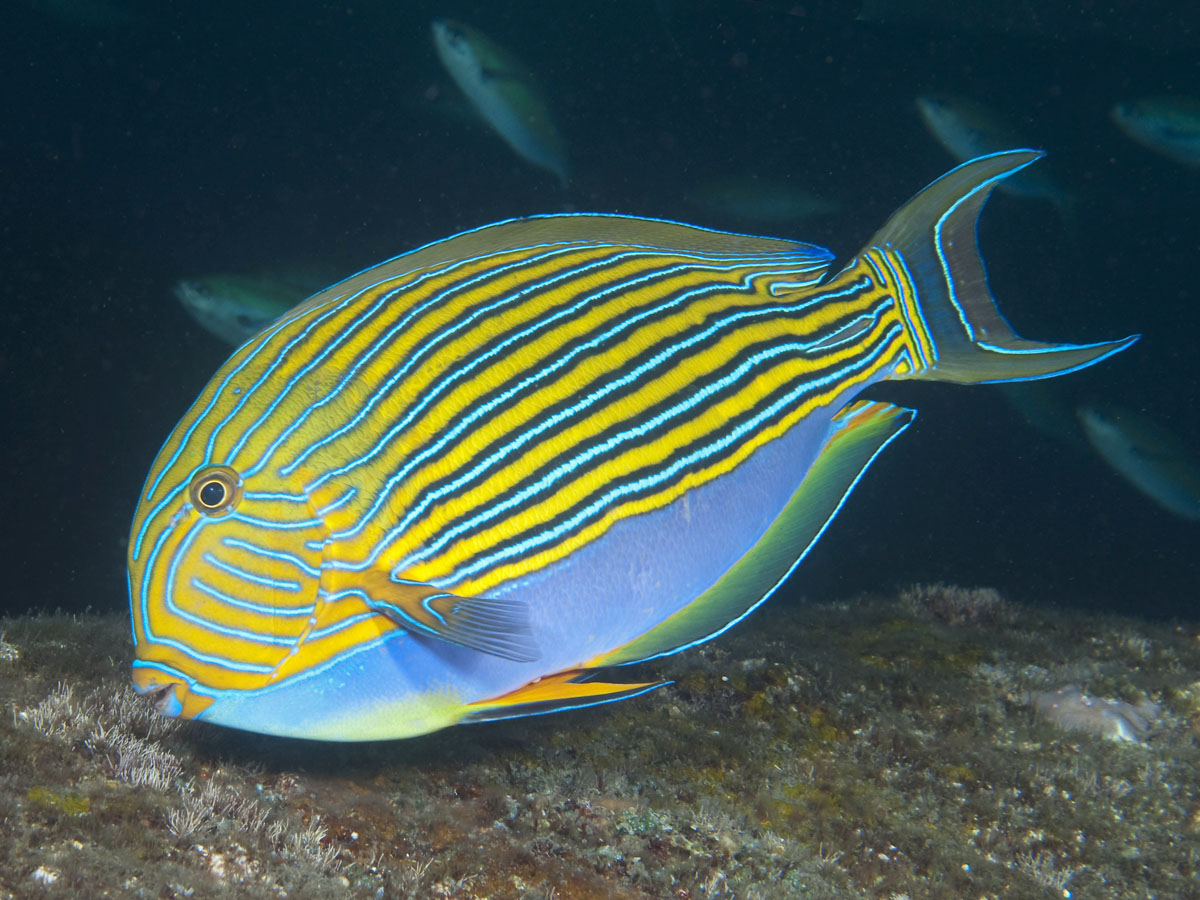
Ctenochaetus striatus
Striated surgeonfish 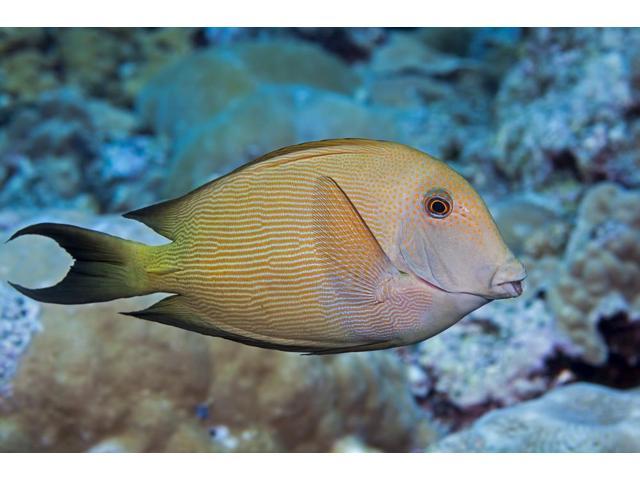
Acanthurus nigricans
Whitecheek surgeonfish 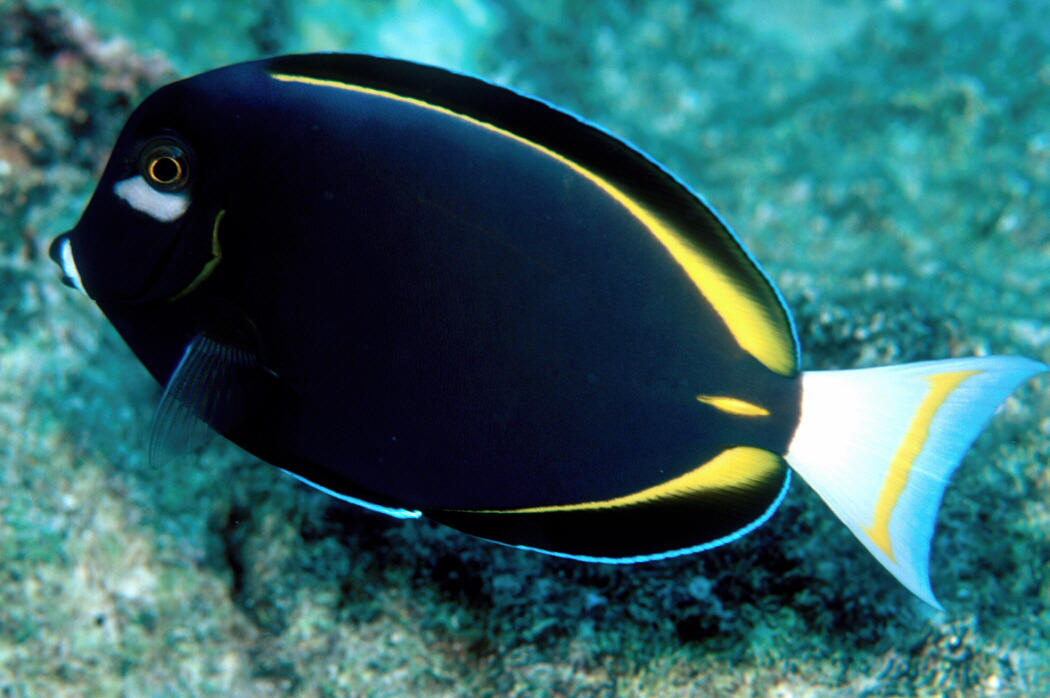
teleosts
An infraclass of the class Actinopterygii, this classification includes most ray-finned fishes found in the world today, with only a few exceptions of ancient fish which branched off earlier in evolutionary history.

hydrophone
A device used to detect sounds underwater.
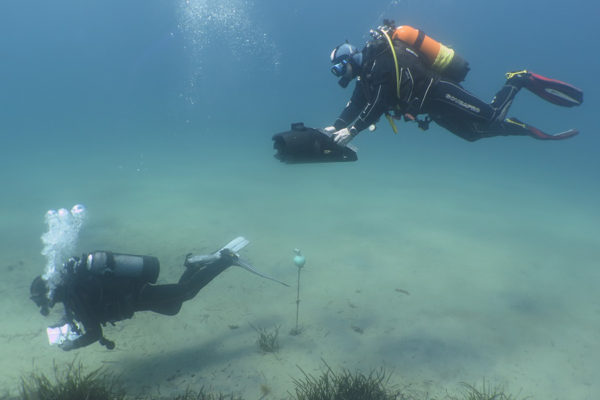
gastric motility
Describes the movements of smooth muscle in the stomach that contract as part of the digestion process.
tonic immobility
Many animals "play dead" in response to a stress or threat, but this trance-like state in sharks is thought to be connected to mating since they typically have few predators to feel threatened by. It typically takes 15 minutes for this effect to wear off and has little or no lasting health consequences for the shark.

V16, V13 and V9 types
The numbers refer to the diameter of the tag, with different sizes being better suited to a range of animal sizes and data types.

temporal resolution
How many measurements are made over a period of time. A measurement is said to be continuous if it is being constantly tracked, whereas discrete measurements are taken periodically at a time interval that the scientists have determined is frequent enough to answer their research question.
backreefs (2–3 m depth, high vertical relief coral, good visibility) which transition to forereefs
This illustration of the anatomy of a barrier reef shows the relative position and depth of the backreef and forereef to the lagoon found at the center of an atoll:

Palmyra
Located in the Pacific, south of Hawaii:
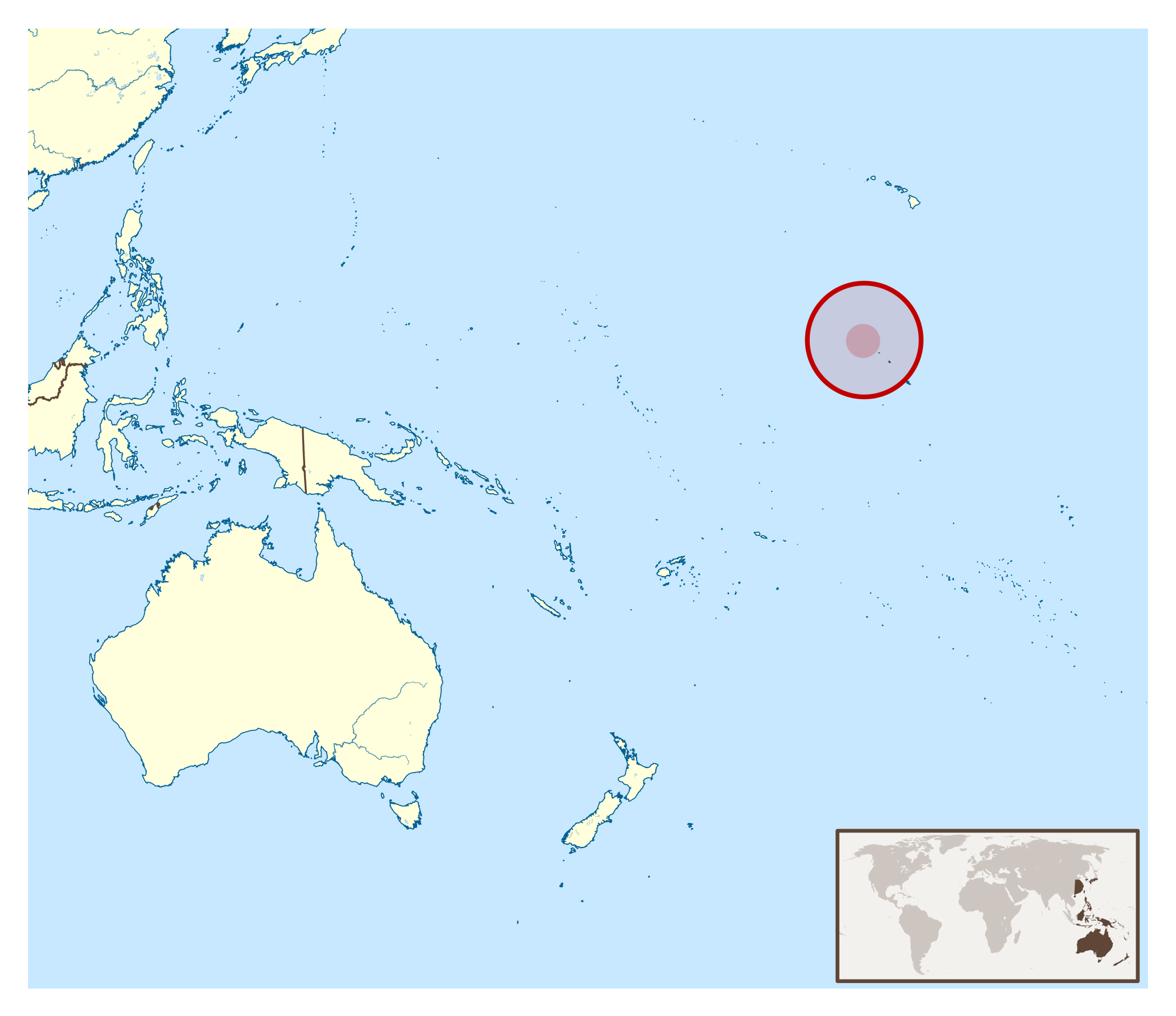 With no permanent residents, this is a United States Minor Outlying Island that is part of the largest marine protected area in the world: the Pacific Remote Islands Marine National Monument.
With no permanent residents, this is a United States Minor Outlying Island that is part of the largest marine protected area in the world: the Pacific Remote Islands Marine National Monument.
behaviourally thermoregulate
Behaviors performed to control the temperature of an organism such as basking in the sun or seeking shelter.
An example of turtles basking in the sun to increase their body temperature:

gastric evacuation
The emptying of the stomach which occurs as food moves on to subsequent stages of digestion and the eventual excretion of wastes.
thermal niche
The temperature conditions within which an organism has the best chance of thriving. This is one of several factors that determine the ecological niche of an organism, which describes how its behavior and habitat choice play a specific role in the context of the larger ecosystem that it is a part of.
Gaussian function
The classic "bell curve" that is used to describe a normal distribution of values. 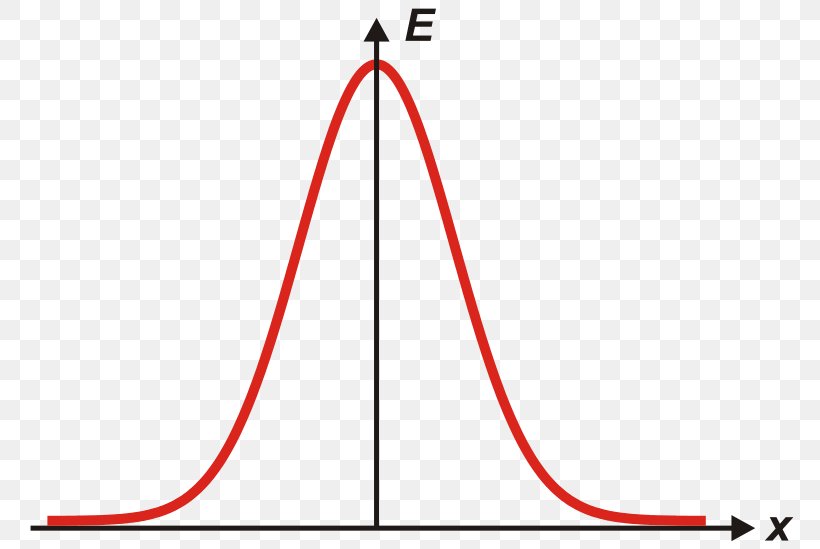
enzyme kinematics
Enzymes perform many important functions in our bodies (such as digestion) and have a temperature at which they can perform optimally. Temperatures that are higher or lower will require more energy to perform the same task. Keeping your body, and the enzymes that it contains, at an optimal temperatures is a way to maximize the efficient use of energy. 